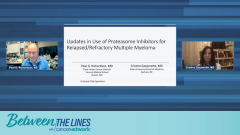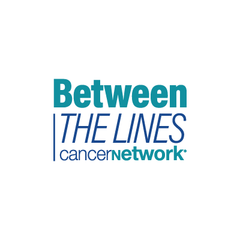
RRMM: Ixazomib Plus Pomalidomide and Dexamethasone
Expert perspectives on the triplet combination of ixazomib, pomalidomide, and dexamethasone in multiple myeloma presented at the 2021 ASH [American Society of Hematology] Annual Meeting.
Episodes in this series

Transcript:
Paul G. Richardson, MD: I am thinking about what you just said, Christina, about the feasibility of your oral regimen and its tolerability in the relapse/refractory space being of primary importance. I thought we could finish our discussion today by focusing on a really interesting new approach in terms of the relapse/refractory space of combining ixazomib with pomalidomide to showcase and discuss with you 2 studies: 1 which was presented by my colleague at ASH in December of last year (2021) and the second study for which there was a press release led by my colleague Peter Voorhees, MD, at the Levine Cancer Institute of Atrium Health in Charlotte, North Carolina, of which you were a much-valued alliance member, and at the same time, just share with our audience the data from the second study which will be presented at EHA [European Hematology Association] in Vienna. But suffice to say that for this first study, this was an exploration of ixazomib combined with pomalidomide, but because we all recognize ixazomib is so well tolerated, is there the capability to go up to higher doses given the relapsed/refractory space, as we'd originally done in the phase 1 effort years ago, and showed that was possible, but do so in a way to be more active. You touched on this very nicely earlier, there is a sense with ixazomib that the weekly dosing is very well tolerated, but the punch of it is somewhat diminished, and you captured that beautifully earlier. With that in mind, I just wanted to review the data with you.
[Next slide, please.] In this study, what we did in the relapsed/refractory space, was to explore 3 dose cohorts. The first dose cohort was at 3 mg of pomalidomide and 3 mg of ixazomib. At the same time, the second dose cohort was 3 mg of ixazomib and 4 mg of pomalidomide, and then the third dose cohort was at 4 mg for both, and we adjusted the steroids, as you'd imagine, for the older folks. What was really interesting was that we were able to actually get up to those level threes: 4 mg of ixazomib twice a week and pomalidomide at 4 mg, a full dose . But critically, I did want to share with everyone that the cycle length was made to be 21 days because we realized that we probably weren't going to be able to continue the pomalidomide for a full 21 days in that setting without overlapping toxicities so we truncated the pomalidomide to 2 weeks on, 1 week off, and the dexamethasone was [unintelligible] on the day of the ixazomib and the day after to improve tolerability, and the ixazomib was given days 1, 4, 8, and 11. I just wonder what your impression of what this data was. Our results, I think you're very familiar with. We were able to get a very solid response rate of approximately 60% with this platform, but in a heavily pretreated population who were enriched for resistance including high-risk cytogenetics, and again, a very favorable tolerability. I just wondered what you thought of this.
Cristina Gasparetto, MD: This is a very important point. I always think of the elderly, and why we are unable to impact the older populations with myeloma, since the survival is shorter. There is nothing different with the biology of the disease, but the difference is that we tend to adjust dosage, we tend to treat them suboptimally because we want to avoid the toxicity. This drug was initially approved in a week and we all had the impression that maybe it was not as strong as bortezomib or carfilzomib. But we had in the back of the mind that maybe the dosage was not correct and that it was a suboptimal dose. I love having a study where the ixazomib is given a full potential in showing the benefit in combination with a pomalidomide, a in this situation. I love the fact that it is an oral combination that is performing quite well, and is tolerable. It's a very important point. We need to treat the patients aggressively. We need to use this drug at the maximum dose to achieve effectiveness. I'm glad that we have a study showing that ixazomib given in the twice-a-week schedule can perform quite well in patients who are heavily pretreated. This was a very good study providing us with good information. When we are choosing a particular combination in the relapse setting, it was a positive and important point.
Paul G. Richardson, MD: Thank you, Cristina. I agree. From my patients participating in the trial, number (1), the combination has been well tolerated, and (2), they've had higher risk disease, had been more heavily pretreated, and at the same time, most were obviously pomalidomide-naïve. They were nonetheless patients in whom I would want a powerful booster inhibitor presence to be effective. These were all then refractory and all the patients had to be relapsed and refractory to enter the study. As I mentioned, they were enriched for high-risk cytogenetics. We were encouraged by what we saw. What's really interesting, and I so agree with you, is that in the context of tolerability and continuity of therapy, or being able to continue treatment, rather, in the COVID era, this was an attractive combination for patients because it was all oral with minimal visits to the clinic. That's a key aspect of all of our regimens, which is, if you can minimize that risk. Also, both you and I have this experience, that whilst we're so impressed by the antibody platforms, there is no doubt that there is a risk of pulmonary infection associated with their use. Obviously, with potent antibodies targeting CD38 there is, of course, a significant effect on B cells broadly, and that leads to hypogammaglobulinemia and all of the things that we think may increase or magnify the risk of infection of whatever source, be it COVID or otherwise.
Transcript edited for clarity.
Newsletter
Stay up to date on recent advances in the multidisciplinary approach to cancer.


































































































